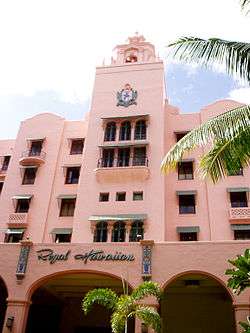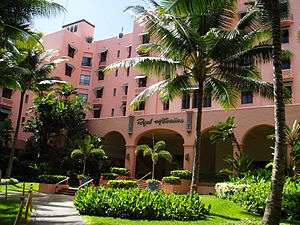Royal Hawaiian Hotel
| The Royal Hawaiian | |
|---|---|
 | |
| General information | |
| Location |
2259 Kalākaua Avenue Waikiki, Honolulu, Hawai'i |
| Coordinates | 21°16′39″N 157°49′44″W / 21.27750°N 157.82889°WCoordinates: 21°16′39″N 157°49′44″W / 21.27750°N 157.82889°W |
| Opening | 1927 |
| Owner | Kyo-ya Company Limited |
| Landlord | Kamehameha Schools |
| Technical details | |
| Floor count | 6; 17 |
| Floor area | 12,000 square feet (1,100 m2) |
| Design and construction | |
| Architect | Warren and Wetmore |
| Other information | |
| Number of rooms | 528 |
| Number of suites | 34 |
| Number of restaurants | 3 |
| Parking |
Valet Self parking at adjacent Sheraton |
| Website | |
| http://www.royal-hawaiian.com | |
The Royal Hawaiian Hotel is a beachfront luxury hotel located in Waikiki in Honolulu, Hawaii, on the island of Oahu. One of the first hotels established in Waikiki, the Royal Hawaiian is considered one of the most luxurious and famous hotels in Hawaiian tourism, and in its nearly 90-year history has been host to numerous celebrities and world dignitaries. The hotel's bright pink hue of its concrete stucco facade with its Spanish/Moorish styled architecture and prominent location on the wide sandy beach have earned it the alliterative nickname of "The Pink Palace of the Pacific".
History
With the success of the early efforts by Matson Navigation Company to provide steamer travel to America's wealthiest families en route to Hawaii, a series of resort hotels were built in Honolulu in the first decades of the Twentieth Century. These included the Moana Hotel (1901) and Honolulu Seaside Hotel, both on Waikiki Beach, and the Alexander Young Hotel in downtown Honolulu (1903).
In 1925, the Territorial Hotel Company, by then owner of all three hotels, decided to demolish the Honolulu Seaside and replace it with a large, modern resort.[1] They hired Warren & Wetmore, the nation's premier hotel architects of the era, to design the Royal Hawaiian Hotel. The sprawling pink stucco concrete facade Spanish/Moorish styled complex, built at a cost of over $5 million (1927 prices), was surrounded by a fifteen-acre landscaped garden. The hotel was built roughly shaped like the letter "H" to catch the trade winds and featured 400 rooms, each with bath and balcony.[1] The hotel also had an offsite golf course, designed by Seth Raynor, today known as the Waialae Country Club. The Matson Line built the ocean liner SS Malolo at the same time in a joint effort to bring tourists to Hawaii.
The Royal Hawaiian opened its doors to guests on February 1, 1927 with a black tie gala attended by over 1,200 guests, and quickly became an icon of Hawaii's glory days. The hotel was a huge success, and in 1928 the islands counted over 20,000 visitors for the first time.[1] Unfortunately the Territorial Hotel Company was bankrupted by the onset of the "Great Depression" by 1929 and the Matson Line took over its hotels in 1932.
During World War II, the Royal Hawaiian was closed to tourists and instead served as a place of rest and relaxation for members of the U.S. military - visiting soldiers, sailors, Marines, and airmen.[2] While the Royal Hawaiian's lush tropical garden was (and still is) tranquil and poetic, on the beaches fronting the "Pink Palace" (sometimes referred to as the "Pink Lady"), one saw reminders of the War with rolls and rolls of barbed wire planted in the sand. The hotel recuperated much of its clientele in the post-war boom of the peacetime later 1940s and 50s. It was sold, along with the rest of Matson's hotels in Hawaii, to the Sheraton Hotels and Resorts chain in 1959.[3]
During the 1960s, the "Pink Palace" was home to "Concert by the Sea" which broadcast daily through the Armed Forces Radio Network (AFN). Soldiers would listen to sounds of home all across Vietnam and Southeast Asia, and then on "R & R" would come to Waikiki to visit the "Pink Palace" in person.
In September 1974,[4] Japanese businessmen and brothers Kenji Osano and Masakuni Osano purchased the Royal Hawaiian Hotel from ITT Sheraton. The Osano brothers formed Kyo-ya Company Limited, a subsidiary of Kokusai Kogyo Company Limited as the corporate entity charged with overseeing the hotels they had bought from Sheraton in Hawaii and California: Sheraton Waikiki Hotel, Moana Hotel, Sheraton Princess Kaiulani Hotel, Sheraton Surfrider Hotel, Sheraton Maui Hotel, Sheraton-Palace Hotel, and Sheraton-West Hotel. The purchases put the Osano brothers on the "Forbes" magazine's "List of World's Richest People in 1999".
After the Osano brothers' deaths, Takamasa Osano inherited their properties, worth billions of dollars. Along with the Moana Hotel, the Royal Hawaiian Hotel continues to be one of the flagship hotels in the Osano corporate empire and is the part-time residence today of the Osano family.
The ground upon which the hotel is built is owned by Kamehameha Schools, which leases the land.[5]
The Royal Hawaiian closed on the 1st of June 2008 for a complete renovation. The historic landmark hostelry reopened on 20th January 2009[6] as a member of The Luxury Collection division of Starwood Hotels. An extended renovation of the Royal Beach Tower was completed in 2010. The Royal Hawaiian Hotel is a member of Historic Hotels of America the official program of the National Trust for Historic Preservation.
Architecture
The Royal Hawaiian cost US $4 million (1927 money) and took one and a half years to build. The six-story structure had 400 rooms and designed in the Spanish and Moorish styles with stucco facades popular in southern California and Florida during the 1920s. The Royal Hawaiian Hotel was also influenced by Hollywood film star and legend Rudolph Valentino and his Arabian movies. Cupolas were created to resemble Spanish Mission style bell towers. The pink color was taken from a popular American obsession of the era. The architects were Warren and Wetmore of New York City.
The hotel's public rooms, notably the Oceanside Lobby and Recreation Lounge, were redecorated in 1946 by Frances Elkins, the sister of architect David Adler.[7]
Notable guests and tenants
As soon as The Royal Hawaiian opened, a non-stop flood of tourists from the mainland United States poured through its doors. It served as the Pacific home to the world's most influential statesmen and early Hollywood stars.
Its first official registered guest was Princess Abigail Kawananakoa, who would have been Queen of the Kingdom of Hawaii had the monarchy survived. Duke Kahanamoku, the legendary Olympic swimmer and popularizer of the sport of surfing, frequented the Royal Hawaiian Hotel restaurants and private beachfront. The Royal Hawaiian Hotel became a favorite stomping ground for Kahanamoku's famed group, dubbed the "Waikiki Beach Boys".
Prior to the 2010 renovation, a framed replica of a Guest Registration Card bearing the signature of then 32nd President Franklin D. Roosevelt, (1882-1945, served 1933-1945), was displayed in a main hallway corridor of the main hotel. The card was dated during the "Great Depression". FDR also visited during the subsequent Second World War during military conferences and tours of nearby Pearl Harbor naval base and to meet with his Supreme Allied Commander in the Pacific Theater, General Douglas MacArthur in July 1944.
Also during World War II, the Royal Hawaiian Hotel became home to many returning sailors off long war patrols.
In popular culture
The hotel has featured in numerous media projects.
In film
- In 1931, the hotel was used in the Charlie Chan film The Black Camel with Warner Oland.
- In 1952, the hotel lobby was captured in the John Wayne film Big Jim McLain.
- In 1952, the hotel appeared in the Tom and Jerry animated/cartoon theatrical short Cruise Cat.
- In 1961, the hotel appeared in scenes of the movie Gidget Goes Hawaiian with Deborah Walley and James Darren.
- In 1978, the hotel was used in the film Goin' Coconuts
- In 2002, the hotel was featured in several scenes of P.T. Anderson's film Punch-Drunk Love.
- In 2014, the hotel appeared in the film Big Eyes
In television
- From 1968 to the mid 1970s, the hotel occasionally was in the background of passing scenes of the long-running popular TV series filmed in the Islands, Hawaii Five-O starring Jack Lord.
- In 1977, the hotel was featured in the Charlie's Angels episode "Angels in Paradise".
- In 1979, the hotel was featured in the Eight Is Enough episode "Fathers and Other Strangers" Parts 1 and 2.
- In 1986, the hotel was featured with two popular shows then in the series Murder She Wrote, - episode "Magnum on Ice", starring Angela Lansbury and guest starring Tom Selleck of the series Magnum P.I.
- In 2002, the hotel appeared in the My Wife and Kids episode "The Kyles Go To Hawaii".
- In 2013, the hotel featured prominently in the Mad Men season 6 premiere, "The Doorway".
In music
- In 1970, the hotel is referenced in Joni Mitchell's song Big Yellow Taxi as the "pink hotel".
Further reading
- Glen Grant (1996). Waikīkī Yesteryear. Mutual Publishing Co. ISBN 1-56647-107-9.
- Don Hibbard and David Franzen (1995). The View from Diamond Head: Royal Residence to Urban Resort. Editions Ltd. ISBN 0-915013-02-9.
- George S. Kanahele (1996). Waikīkī, 100 BC to 1900 AD: An Untold Story. University of Hawaiʻi Press. ISBN 0-8248-1790-7.
Gallery
- The Royal Hawaiian
 The Royal Hawaiian
The Royal Hawaiian- The Royal Hawaiian
- Royal Hawaiian seen from Waikiki Beach
- The Royal Hawaiian and Diamond Head, seen from the Sheraton Waikiki
 The Royal Hawaiian, with the modern Sheraton Waikiki behind it
The Royal Hawaiian, with the modern Sheraton Waikiki behind it The Royal Hawaiian, seen from the sea
The Royal Hawaiian, seen from the sea The same view in 1969.
The same view in 1969.
References
- 1 2 3 Hibbard, Don (1 January 2006). "Designing Paradise: The Allure of the Hawaiian Resort". Princeton Architectural Press. Retrieved 19 September 2016 – via Google Books.
- ↑ Richard O'Kane (1977). Clear the Bridge!. Rand McNally.
- ↑ http://www.hawaiihotel.org/top-resorts-in-hawaii.html
- ↑ "Timeline". Retrieved 19 September 2016.
- ↑ "Royal Hawaiian". Kamehameha Schools. Retrieved January 5, 2015.
- ↑ "Royal Hawaiian has renovation deal". Star-Bulletin. Jan 11, 2009.
- ↑ Stephen M. Salny (2005). Frances Elkins: Interior Design. W. W. Norton. pp. 146–147.